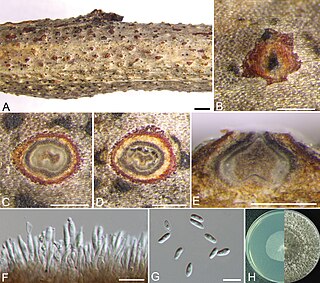The San Lucan skink is a skink native to the Baja California Peninsula.

Diaporthe perniciosa a species of fungus in the family Diaporthaceae. It is a plant pathogen.
Diaporthe arctii is a fungal plant pathogen.
Diaporthe dulcamarae is a fungal plant pathogen of the genus Diaporthe.

Diaporthe eres is a fungal plant pathogen, which is the type species of genus ''Diaporthe''. It causes canker disease in a wide variety of hosts. This species has a long history, having been described many times under various synonyms, for instance, the fungus was illustrated by James Sowerby in 1803 under the name Sphaeria ciliaris, attributed to Bulliard. The name D. eres has been proposed for conservation in order to avoid bothersome name changes due to priority.
Diaporthe phaseolorum var. phaseolorum is a plant pathogen infecting soybean, sweet potato and peanut.

Diaporthe phaseolorum is a plant pathogen with five subspecies:

Diaporthe phaseolorum var. sojae is a plant pathogen infecting soybean and peanut.

Diaporthales is an order of sac fungi.

Phomopsis is a genus of ascomycete fungi in the family Diaporthaceae. It was previously in the Valsaceae family.

Diaporthaceae is a plant pathogen family.

Diaporthe is a genus of endophytic filamentous fungal plant pathogens.
Diaporthe toxica is a lupin endophyte and occasionally a plant pathogen. The fungus produces secondary metabolites that result in toxicosis of animals such as lupinosis of sheep when infected lupins are ingested by animals. The fungus produces mycotoxins called phomopsins, which cause liver damage. Lupinosis has been incorrectly attributed to Diaporthe woodii but has now been shown to be a mycotoxicosis caused by the recently discovered (1994) teleomorphic fungus Diaporthe toxica. The discovery and naming of this fungus concludes over a century of investigation into the cause of lupinosis since the first major outbreak in Germany in 1872. The infection process and life cycle in both resistant and susceptible lupins has been fully elucidated. This is the first record of resistance in a latent infection. Following this research rapid molecular breeding techniques have been developed leading to the production of many resistant lupin varieties. Lupinosis is no longer considered a disease of major importance to livestock producers in Western Australia. Lupins can now become part of the human diet.
A. lagunensis may refer to:
D. lagunensis may refer to:
The Nanfengmiju is a rare non-hybrid citrus.
Diaporthe fraxini-angustifoliae is a plant endophyte and occasionally a plant pathogen, first found on Fraxinus angustifolia subsp. oxycarpa in Australia.
Diaporthe litchicola is a plant endophyte and occasionally a plant pathogen, first found on Litchi chinensis in Australia.
Diaporthe salicicola is a plant endophyte and occasionally a plant pathogen, first found on Salix purpurea in Australia.
Aureoumbra lagunensis is a unicellular planktonic marine microalga that belongs in the genus Aureoumbra under the class Pelagophyceae. It is similar in morphology and pigments to Aureococcus anophagefferens and Pelagococcus subviridis. The cell shape is spherical to subspherical and is 2.5 to 5.0 μm in diameter. It is golden-coloured and is encapsulated with extracellular polysaccharide layers and has a single chloroplast structure with pigments.





